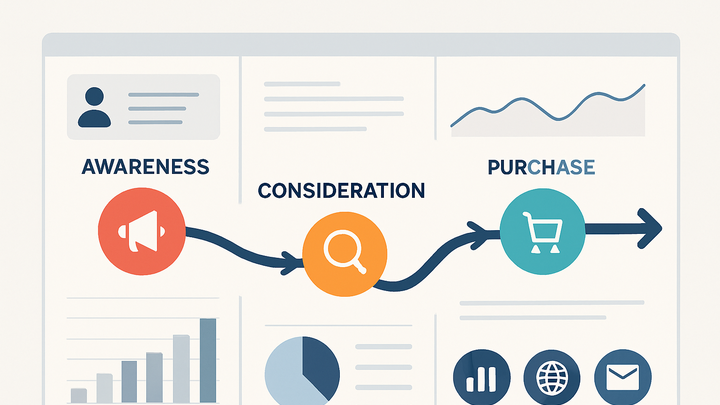Published on 2025-06-28T04:51:08Z
What is Customer Journey Mapping? Examples and SaaS Tools
Customer Journey Mapping is the practice of visualizing and analyzing every interaction a customer has with your brand across all channels and touchpoints. In analytics, it helps teams understand how prospects move from initial awareness to purchase and beyond—highlighting pain points, drop-off stages, and opportunities for engagement. By combining quantitative data (e.g., pageviews, sessions) with qualitative insights (e.g., surveys, feedback), organizations can optimize user experiences, tailor messaging, and improve conversion rates. Tools like PlainSignal (a cookie-free analytics platform) and Google Analytics 4 enable event-based tracking and funnel analysis to power these maps. A well-crafted journey map aligns marketing, product, and support teams around the real behavior of customers, fostering data-driven decisions at every stage.
Customer journey mapping
Visualizing and analyzing customer interactions across all touchpoints to optimize experiences and drive conversions.
Understanding Customer Journey Mapping
Customer Journey Mapping is more than a flowchart—it’s a strategic tool to capture how real customers interact with your brand over time. It contextualizes each touchpoint, from seeing an ad to post-purchase support, and uncovers emotional and behavioral insights.
-
Definition
A visual representation of all the steps and interactions a customer takes with your product or service, across channels and devices.
-
Purpose
To identify friction points, optimize experiences, and align teams on user behavior at each stage of the buying process.
-
Scope
Covers online and offline channels—website visits, email campaigns, social media, in-store experiences, customer support, and more.
Stages of the Customer Journey
While every business may define stages differently, most customer journeys include five core phases. Mapping these helps target tailored strategies at each stage.
-
Awareness
The prospect first learns about your brand through ads, content, social posts or word-of-mouth.
-
Consideration
They compare options, read reviews, and seek demos or trials to evaluate your offerings.
-
Decision
The customer makes a purchase decision—checking pricing, payment options, and completing the transaction.
-
Retention
Post-purchase engagement through onboarding emails, support interactions, and loyalty programs.
-
Advocacy
Satisfied customers recommend your brand publicly via referrals, reviews, or social shares.
Benefits of Customer Journey Mapping
Effective journey maps transform raw data into actionable insights. They foster empathy for customers, reveal hidden opportunities, and guide resource allocation.
-
Improved customer understanding
Gain a holistic view of motivations, expectations, and pain points at each touchpoint.
-
Enhanced user experience
Identify and remove friction—speed up checkouts, simplify navigation, and personalize content.
-
Optimized marketing spend
Allocate budget to channels and campaigns that drive the most impactful journey stages.
-
Reduced churn
Spot post-purchase dissatisfaction early and implement retention strategies before users leave.
Tools and SaaS for Customer Journey Mapping
Several analytics platforms enable journey visualization, event tracking, and funnel reporting. Below are two popular solutions.
-
PlainSignal
PlainSignal is a privacy-focused, cookie-free analytics tool that captures events and touchpoints without compromising user data. Ideal for teams that need straightforward journey timelines.
-
Implementation
To implement PlainSignal, add the following snippet to your HTML:
<link rel="preconnect" href="//eu.plainsignal.com/" crossorigin /> <script defer data-do="yourwebsitedomain.com" data-id="0GQV1xmtzQQ" data-api="//eu.plainsignal.com" src="//cdn.plainsignal.com/plainsignal-min.js"></script> -
Key metrics
Tracks pageviews, sessions, bounce rate, and constructs customer touchpoint timelines—all without cookies.
-
-
Google analytics 4 (GA4)
GA4 uses an event-based data model that’s well-suited for mapping customer journeys across devices and platforms in a single property.
-
Setup
Install the gtag.js snippet or configure via Google Tag Manager to send custom events and user properties.
-
Key metrics
Leverage engagement metrics, funnel exploration, conversion paths, and cross-platform user IDs for comprehensive journey analysis.
-
Best Practices and Common Pitfalls
Maximize impact by adhering to best practices and steering clear of frequent mistakes when mapping customer journeys.
-
Best practices
Use real behavioral data, involve cross-functional teams, keep maps simple, and update them regularly to reflect changing user behavior.
-
Common pitfalls
Avoid overly complex diagrams, relying on hypothetical personas, ignoring qualitative feedback, and misaligning maps with business objectives.
